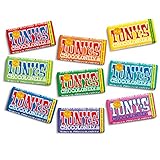We can't find the internet
Attempting to reconnect
Something went wrong!
Hang in there while we get back on track
When you buy through links on our site, we may earn an affiliate commission. Learn more
chocolate
by Jason Denney
There are some serious problems with the farming of cacao. Sixty percent of the worlds chocolate comes from Africa, and most of the farmers are living in drastic poverty, and this incentivizes farming families to utilize child labor, keeping them out of schools for a chance for a better future. On top of that, some farmers intentionally traffick children with the promises of good pay then treat them as slaves. For more details watch the Dark Side of Chocolate documentary.
As a food item, there are the standard environmental concerns: cultivation, transportation, processing, & packaging. The cacao ideally would be grown organic, however this is rare in the chocolate world, as it’s hard to encourage struggling farmers to adopt new practices. Most advocates for ethically sourced cacao are trying to address the poverty issue first before advancing organic practices. Regarding transportation, the cacao is only grown in tropical regions, so it has to be transported overseas and imported adding to its carbon footprint. Processing wise, most chocolate is roasted; however, a new trend is “raw” chocolate. The raw variety should technically have a lower carbon footprint and additionally is marketed as having better nutrition and antioxidants (though not verified by any studies). A lot of chocolate manufacturers add in palm oil which has its own environmental issues, so best to avoid that additive. Packaging-wise, chocolate should ideally be plastic-free (goodbye “fun sized” individually wrapped up little turds you like to call chocolate).
Certifications to the rescue! Maybe?
To help avoid supporting these problems, there’s a number of 3rd party certifications you can look out for on your labels. Note that a lot of the large corporate manufacturers have started creating their own certifications that have little auditing and transparency, so don’t just assume that any certification on the label is good enough, look for these specific ones:
Fairtrade - aims to tackle price volatility, which is very dangerous for small farmers who have very little ability to insure themselves against risks. Fairtrade thus guarantees farmers a minimum price, and a fixed premium on top. Some labor and environmental standards are also incorporated into the standard.
Rainforest Alliance - focus on production regulations, is stronger on environmental protection, bans deforestation of any kind
UTZ - production regulations
Direct Trade - cut out middlemen to improve price margins for farmers and easier to audit farmer practices
Random tidbit, Tony’s Chocolonely is throwing some blockchain into the chocolate world for a tamper-proof cacao tracking system.
To summarize, all of the major chocolate labels like Nestle & Hershey are not doing enough to produce ethical and eco-friendly chocolate. Keep in mind that chocolate is an exotic good that should be treated as a luxury, so buy less of it and just save up to buy some good fancy ethical shiiiight. For an extensive list of good chocolate brands to buy (or avoid), check out the Food Empowerment Project’s chocolate list.
UPDATE
An additional concern with dark chocolate involves how cacao has a tendency to absorb hard metals like lead and cadmium. So, perhaps yet another reason to make dark chocolate an occasional treat.
Resources:
-
https://www.ethicalconsumer.org/food-drink/shopping-guide/chocolate
-
https://recipes.howstuffworks.com/chocolate-big-cravings-and-even-bigger-carbon-footprint.htm
-
https://www.onegreenplanet.org/animalsandnature/how-ethical-is-your-chocolate/
-
https://allthenourishingthings.com/bitter-truth-chocolate-ethical-chocolate-options/
-
https://www.thedailybeast.com/lawsuit-your-candy-bar-was-made-by-child-slaves
-
https://www.salon.com/2017/12/01/the-ethical-sustainable-chocolate-you-love-may-be-a-fraud_partner/
Want more? Become an Intentful Consumer!
Get updates on new research and products. Upvote, comment, and add suggestions to help others.




